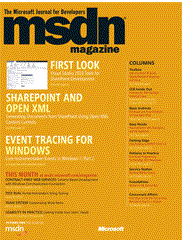
October 2009
First Look:Visual Studio 2010 Tools for SharePoint Development
This article provides a first look at tools in Visual Studio 2010 designed to support development and deployment of SharePoint 2010 solutions. The article provides an example of designing and deploying a visual Web part. Steve Fox
SharePoint and Open XML:Generating Documents from SharePoint Using Open XML Content Controls
This article describes how to generate documents that contain data stored in SharePoint lists. The example demonstrates how OpenXML content controls can be defined to capture list data in a Word document and how LINQ to XML can be used to query the lists. The documents are generated from a SharePoint Web Part. Eric White
Event Tracing For Windows:Core Instrumentation Events in Windows 7, Part 2
In Part 2, the authors cover core OS Event Tracing for Windows (ETW) events as well as present simple scripts to demonstrate a few basic accounting techniques on some of the OS events introduced. Alex Bendetov, Insung Park
Contract-First Web Services:Schema-based Development with Windows Communication Foundation
Schema- first contract-first modeling of Web Services gives you the ability to model your contracts with an XML-centric mindset. This process keeps you focused on universally acceptable types and the hierarchical data structures that can be represented in XML. Christian Weyer, Buddhike de Silva
Columns
Editor's Note:The Capability-Delivery Business
This month’s issue of MSDN Magazine takes a look at some of the new features and tools in Visual Studio 2010 and Microsoft .NET Framework 4 that will continue improving the experience of creating business applications that run on the Microsoft Office platform. This is an area of software development that holds tremendous potential in terms of solving the right problems—those being the business problems. To get to the next step of really transforming the manner in which business is conducted, highly domain-specific functionality must be developed below the metaphorical surface—and thus can only be meaningfully implemented by you.Howard Dierking
Toolbox:User Interfaces, Podcasts, Object-Relational Mappings and More
This column covers common user interface groupings, configuring NHibernate using C#, and a look at interesting books and podcasts.Scott Mitchell
CLR Inside Out:Profiling the .NET Garbage-Collected Heap
In this article, the authors complete the picture for Garbage Collected (GC) heap related memory issues by providing step-by-step instructions on using the CLR Profiler for .NET GC heap memory investigations.Subramanian Ramaswamy, Vance Morrison
Basic Instincts:Collection and Array Initializers In Visual Basic 2010
Collection Initializers are a great addition to the language and allows concise syntax in order to initialize both framework and user defined collection types.Spotty Bowles
Data Points:Data Validation with Silverlight 3 and the DataForm
In this article, the author reviews the pillars of real-world AJAX development as supported in ASP.NET AJAX 4.0. It focuses on client-side templates and data binding but won’t ignore other goodies, such as ADO.NET Data Services proxy classes and programming facilities.John Papa
Cutting Edge:Data Binding in ASP.NET AJAX 4.0
In this article, Dino reviews the pillars of real-world AJAX development as supported in ASP.NET AJAX 4.0. In doing so, he mostly focuses on client-side templates and data-binding but doesn’t ignore other goodies, such as ADO.NET Data Services proxy classes and programming facilities.Dino Esposito
Patterns in Practice:Functional Programming for Everyday .NET Developers
This article examines how the new support for functional programming techniques in .NET 3.5 can developers make code more declarative, reduce errors in code, and write fewer lines of code for many common tasks.Jeremy Miller
Team System:Customizing Work Items
Team Foundation Server’s work iIem tracking system provides a number of advanced customization options.This article explores custom control support that lets you link to date, enhance the user experience, present data, and more.Brian A. Randell
Test Run:Partial Anitrandom String Testing
This column presents an approach to Antirandom (AR) testing the author calls partial AR string testing, which can be used to test a wide range of software systems.James McCaffrey
Service Station:Building RESTful Clients
This column how to build clients applications based on the REST architecture using HTTP AP1s. The article describes how to address the question of autogenerated types and code.Jon Flanders
Foundations:Routers in the Service Bus
This article describes aspects of using routers with the .NET service bus, especially their use in a message-based architecture.Juval Lowy
Concurrent Affairs:Four Ways to Use the Concurrency Runtime in Your C++ Projects
This article describes how to integrate the new parallel computing libraries in the Visual Studio 2010 Beta into existing C++ projects. Based on four common scenarios, the column explains a few of the ways developers can use the APIs and classes that are part of the Parallel Pattern Library (PPL), Asynchronous Agents Library, and Concurrency Runtime.Rick Molloy
Usability in Practice:Getting Inside Your Users’ Heads
This article explores techniques developers can use to gather information about and incorporate their users' mental models in their software designs.Ambrose Little, Charles B. Kreitzberg

